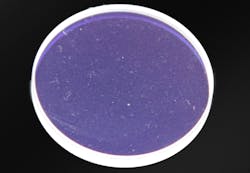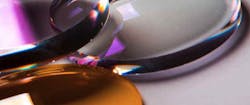Optical Coating
An optical coating is a thin-film deposit used to enhance transmission, change reflective properties, or change the polarization of light transmitted through an optical component.
Shanghai Optics can provide all types of anti-reflective, high reflective, and partial reflective coatings. We produce a wide variety of coatings from a single layer of anti-reflective coating to complex multilayer dielectric stacks. Types of dielectric coatings are BBAR, V-coatings, dual wavelength coatings, and sharp cut-on and cut-off filters.
Examples of Optical Coatings
- An anti reflective coating reduces unwanted reflection. For instance, a standard uncoated glass component will reflect about 4% of incident light. The same glass component with an AR coating tailored for the wavelength of light being transmitted might reflect less than 0.1% of incident light. We offer a variety of different dielectric anti reflective coatings, including both broadband and narrow band options. One versatile and hardwearing option is magnesium fluoride, which comes in both single-film and multiple layer options.
- A reflective coating causes the surface to which it is applied to reflect all or some of the light which hits it. Consider again the uncoated glass optic with 4% reflection. An aluminum coating will cause the same optic to reflect 88092% of visible light. Silver coatings reflect 95-99% into the far infrared regions (reflection will be lower in the UV and some parts of the visible spectrum), and an appropriately chosen dielectric coating could increase reflectivity to 99.9%. Dielectric mirror coatings are often formed of two discrete repeating layers, one with a high index (for instance, ZnS or TiO2), and one with a low index (think MgF or SiO2).
- A polarizing coating is formed of a very thin film of a birefringent materials. Under certain circumstances, a polarizing coating on a lens or optical window can be used to replace polarizing prisms in an optical assembly.
- A transparent conductive coating is a special type of coating the combines high transmission of visible light and electrical conductivity. The resistivity of a transparent conductive coating is specified in ohms per square, and may be anywhere from 4-1,000 ohms per square depending on application.
Optical Coating Manufacturing
At Shanghai Optics we use a variety of different methods to produce high quality optical coatings. These methods include plasma sputtering, ion beam sputtering, atomic layer deposition, and evaporative deposition.
Ion beam sputtering and atomic layer deposition provide the highest spectral performance, high durability and high repeatability; but the manufacturing process is slow and expensive. Evaporative deposition is more budget friendly, and plasma sputtering provides a good middle ground with reasonable quality and reasonable performance.
Ion Beam Sputtering
In ion beam sputtering (IBS) we use a high energy electric field to accelerate a beam of ions, giving them kinetic energy of 10-100 eV. The ion beam hits the source material, and ions from this material sputter onto the optical surface. A dense film is formed upon contact. Since every step of this process is carefully monitored and precisely controlled, the result is a highly consistent coating that meets design specifications and parameters precisely. IBS coatings can even have less roughness than the original substrate does. This is the method used to make “super mirrors”, special coated mirrors with a reflectivity of more than 99.99%.
Atomic Layer Deposition (ALD)
In atomic layer deposition the optic to be coated is placed in a vacuum chamber, often at elevated temperatures. The coating substance is delivered as a gas, in pulses. During each pulse a single layer adheres, and then the vacuum chamber is evacuated in preparation for the next pulse. The benefit of this method is an extremely high level of control in layer thickness and composition of the layers of material, and the ability to uniformly coat optics with any geometry. The only negative side to this method is that it is slow, and hence expensive to run.
Custom Optical Coatings
The final properties of a dielectric coating will depend on the coating materials used in the thin film layers—especially their refractive index. Changing the layer thickness and the number of layers can also completely change the function of a thin film coating. The ideal optical coating designs for your application will depend on your wavelength range and work environment as well as on your project budget. Our design team has many years of experience and we would be happy to help you determine the custom optical coatings that best fit your application.





